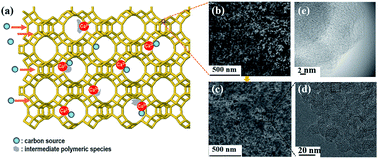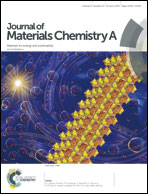Zeolite-templated nanoporous carbon for high-performance supercapacitors†
Abstract
Hierarchical porous carbon prepared with calcium-containing nanocrystalline beta zeolite as the template and ethylene as the carbon source at a relatively low carbonization temperature (600 °C) displayed excellent electrocapacitive properties. The presence of both micro/mesopores and surface oxygen-containing groups on the ordered porous structure, along with a high specific surface area (2280 m2 g−1) and pore volume (1.95 cm3 g−1) coupled with good wettability towards the electrolyte enabled the carbon to perform well as a supercapacitor electrode. This carbon electrode achieved a specific capacitance of 250 F g−1 at a current density of 1 A g−1 with 1 M H2SO4 as the aqueous electrolyte measured in a three-electrode system. A symmetric capacitor fabricated with the carbon as both electrodes exhibited a specific capacitance of 161 F g−1 at a current density of 1 A g−1, and an excellent cycling stability. After being cycled 17 000 times and shelved for another two months, the electrode exhibited a specific capacitance of 246 F g−1 at 1 A g−1, 153% of the initial capacitance, and still maintained an excellent cycle stability. Besides, an all-solid-state supercapacitor cell fabricated with this carbon as both electrodes and polyvinyl alcohol/H2SO4 gel as the electrolyte displayed an areal specific capacitance of 413 mF cm−2 at a current density of 0.25 mA cm−2.



 Please wait while we load your content...
Please wait while we load your content...
